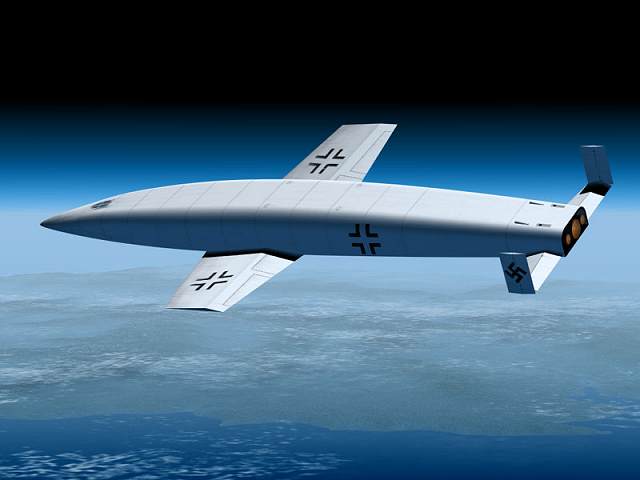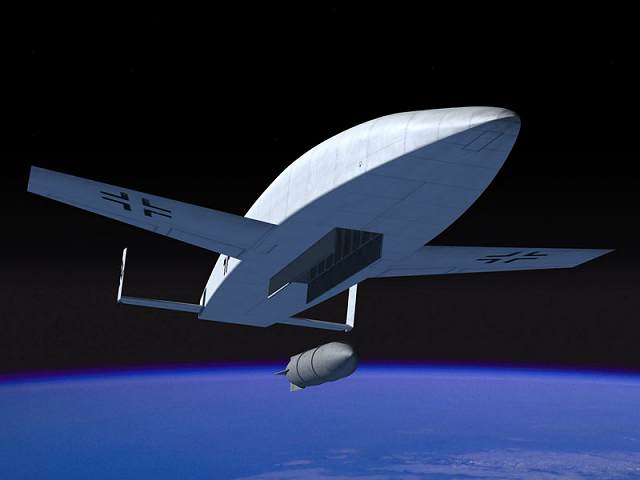 |
| from: http://kswong8d.blogspot.com/2011/08/e100-tiger-maus-henschels-heavy-tank.html |
The Panzerabwehrrakete X-7 "Rotkäppchen" (Red Riding Hood) was a anti-tank missile. Designed and developed by Ruhrstahl AG in 1943.
The X-7 was shell shaped body had two wings at its aft end with parabolic leading and trailing edges and two small pods for the wire link spools were attached to the wing tips. The wire link control system was employed for the X-7 Rotkäppchen which used Düsseldorf FuG 510 transmitter and the Detmold FuG 238 receiver, also a radio controlled system was planned for the X-7 Rotkäppchen using the FuG 203/230h. Detonation was achieved by use of an impact fuse.
trials were undertaken on September 21st 1944 with seven X-7 missiles. Because of the unusual and unfamiliar flying characteristics the first four weapons had ground contact after some distance and therefore crashed. On the next two the rocket engine exploded on the way to the target. The last Rotkäppchen flew all the way and hit the target tank at a range of 500m dead center.
Only about 300 X-7 Rotkäppchen were completed; mass production was planned and had already started at the companies Ruhrstahlwerke in Brackwede and the Mechanische Werke in Neubrandenburg. Many almost finished weapons were captured by the allies (which the French continued to develop after the war). There were unconfirmed reports of the X-7 being used operationally on the eastern front, and it appears that this missile was extremely effective even against the heavy armoured Stalin tanks.
Type: Anti-tank Missile
Guidance system: Wire Guided / Radio Guided (planned)
Length: 0.95 m
Wingspan: 0.60 m
Diameter: 0.15 m
Weight: 9 kg
Engine: 2 × WASAG 109-506 solid fuel rocket engine producing up to kg of thrust
Maximum speed: 360 km/h
Range: 1,2 km
Warhead: 2.5 kg
Fuze: impact fuse
Operators: Luftwaffe
(Data from: http://www.wehrmacht-history.com/luftwaffe/missiles/x7-rotkaeppchen-anti-tank-missile.htm)
More to be found at the Weapons and Warfare blog here:
http://weaponsandwarfare.com/2015/11/04/panzerabwehrrakete-x-7-rotkappchen/
Brian has already made up some rules for a Stug variant with an X-7 launcher at his great Weird WW2 Blog here. Great minds think alike I guess!
You can certainly see older, small chassis getting a new lease of life with this small launcher fitted.
"1946 Racket AT Misile tank" Late WW2/'46 German AT Guided Missile vehicle. Based on a Panzerjager IV chassis and using the X-7 Rotkappchen Missile. From http://www.modelblokez.org.au/othermodels.html#prettyPhoto
More to be found at the Weapons and Warfare blog here:
http://weaponsandwarfare.com/2015/11/04/panzerabwehrrakete-x-7-rotkappchen/
Brian has already made up some rules for a Stug variant with an X-7 launcher at his great Weird WW2 Blog here. Great minds think alike I guess!
 |
| From http://www.weirdwwii.com/2012/10/battleground-weird-wwii-panzerjager-ivr.html |
"1946 Racket AT Misile tank" Late WW2/'46 German AT Guided Missile vehicle. Based on a Panzerjager IV chassis and using the X-7 Rotkappchen Missile. From http://www.modelblokez.org.au/othermodels.html#prettyPhoto
And here is the Pz.IV Raketenwerfer: Missile tank on Panzer IV chassis, armed with four wire-guided Х-7 Rottkapptchen AT missiles". A single prototype was made.
From Achtung Panzer: "It was also planned to arm Panzerkampfwagen IV Ausf C/D/E with four 280mm or 300mm rocket projectors mounted in a special turret, which replaced the standard one. Turret consisted of forward mounted cabin with machine gun and rear mounted hydraulically operated launching frame. A single prototype was produced and tested although full-scale production did not take place. It was designated as Raketenwerfer auf Fahrgestell PzKpfw IV."
 |
| Model version - lots more profile pics from the source site here: http://www.militarymodelling.com/news/article/raketenwerfer-auf-fahrgestell-pzkpfwiv/3844 |







































